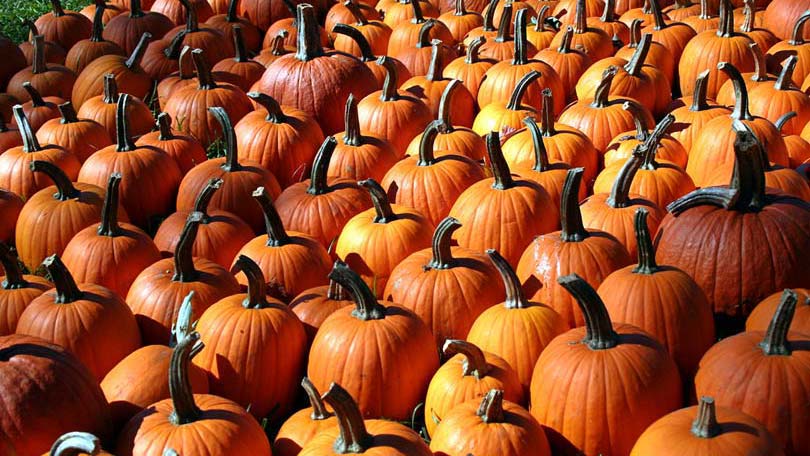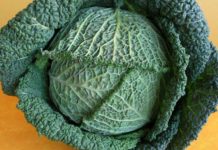
There’s a reason pumpkins resemble balls of sunshine – because they require so much of it. The sunnier their location, the better. Tales of monster squash at the Alaska State Fair are absolutely true. Veggies there gain their colossal size because the days are so long during their growing period. More light equals more food. You don’t have to live in Alaska to grow pumpkins of any size. They do, however, prefer direct sunlight for many hours of the day. Once you’ve located a sunny spot in your garden, yard, carport, or back deck, you can plan your pumpkin patch.
It doesn’t take much space to grow pumpkins. Vines can creep well over thirty feet in length, but that doesn’t have to be on dirt. It isn’t uncommon to see vines trailing down barrels, over latticework or up fences. Be reasonable with the amount of seeds you sow, determined only be the limitations of your location. Even a small back porch is big enough for two pumpkin plants. Train and support them with nails or posts to go where you want them to grow. If gourds develop in the air, you can either pluck them as babies, or create a sling to support their growing weight. Some choose varieties that are small so that they have a wall of little jack-o-lanterns come harvest time.
Obviously, the ideal location for a pumpkin patch is a large area that has rich soil and lots of sunlight. It doesn’t have to be flat. In fact, there is a theory that these plants get really happy when given the chance to race down hills. They seem to grow more vigorously with gravity urging their wanderings. This is one reason pumpkins are grown on mounds. Another is that wider beds are more economical with regard to water conservation, weed suppression, and root development for any plant.
Once you’ve located a sunny area and determined how many plants are appropriate for the space you have, you can decide if containers, wide beds, mounds or flat land sowing is best for your situation. Once you’ve decided, you’ll want to amend your soil with compost as maturing pumpkins thrive on lots of nutrients.
Seeding to Harvest
Start your pumpkins indoors for faster growing rates. Soaking them overnight in water before planting will help them sprout quicker. Plant them in a light potting medium because seeds are so large and can otherwise absorb too much water. To avoid dampening off, add vermiculite and perlite to peat moss for a good planting mixture. As an alternative, you can plant in peat pots, and then insert the whole thing into the ground to prevent root damage.
It takes about ten days for a seed to get to transplanting stage. During this time, seedlings need warmth, fresh air, and up to 24 hours of close light. When seedlings get to their three-leaf stage, it’s time to transplant. You don’t have to harden off seedlings, but they should be protected by greenhouse plastic — or something to help warm the ground and circulating air – above the little plants. Give them just enough water to soak up, but not so much that it puddles. Seedlings should never be in standing water.
As these seedlings mature over the next 60-70 days, they will need to eat. Feed them diluted fish emulsion or rabbit tea once every few weeks. During this time, a main vine will develop and grow one way, and a secondary vine will tend to grow the other way. Small, insignificant vines will grow off these and can be pruned. In fact, many farmers prune small, immature fruit that form on side shoots. Microgardeners, those who produce a lot of food in a small area, train the vines in spiraling circles around containers. The plants are versatile enough to accommodate a variety of needs and space requirements.
Just as varied as their growing habits are the varieties of pumpkins you can grow. Pumpkins are many things, but they are not technically squash or gourds. All three are actually in the Cucurbitaceae family, although the Greek root for pumpkin literally means: large melon. The pumpkin family has many members, and some of those are really squash. Whatever you call them, you can find one to fit your needs. Read and ask local recommendations according to your preferences. For example, pumpkins that are great for canning don’t store well, while others last for months in a cool, dry area. You can find seeds for tiny jack-o-lanterns or humongous boats.
Whatever variety you choose, your pumpkin patch joins you with a gardening tradition that’s been going on for centuries. Start a custom in your family. Plant pumpkins every year. Watch them sprawl throughout the growing season, burst forth with flowers then fruit that ripens in a magnificent display. Enjoy the harvest; eat and collect seeds for next season.





